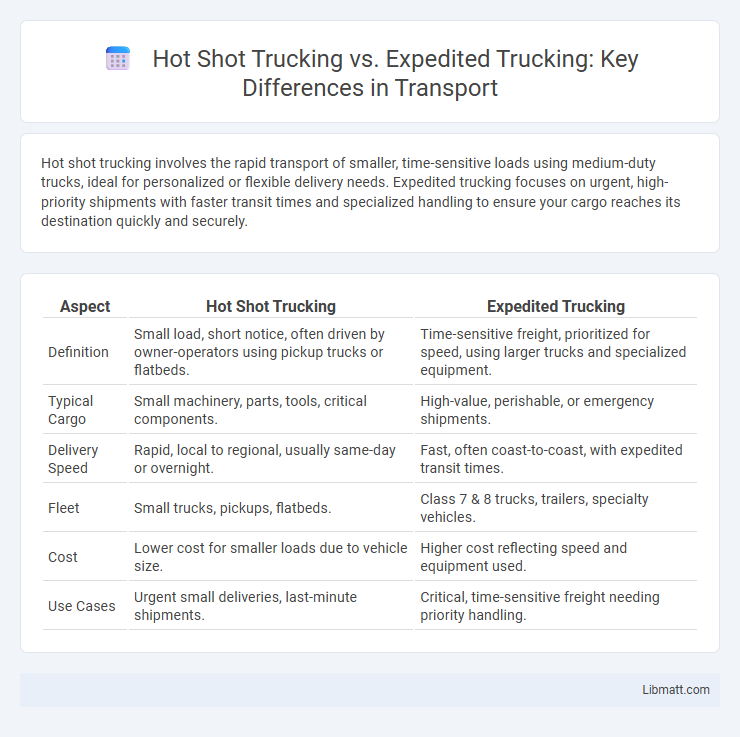Hot shot trucking involves the rapid transport of smaller, time-sensitive loads using medium-duty trucks, ideal for personalized or flexible delivery needs. Expedited trucking focuses on urgent, high-priority shipments with faster transit times and specialized handling to ensure your cargo reaches its destination quickly and securely.
Table of Comparison
| Aspect | Hot Shot Trucking | Expedited Trucking |
|---|---|---|
| Definition | Small load, short notice, often driven by owner-operators using pickup trucks or flatbeds. | Time-sensitive freight, prioritized for speed, using larger trucks and specialized equipment. |
| Typical Cargo | Small machinery, parts, tools, critical components. | High-value, perishable, or emergency shipments. |
| Delivery Speed | Rapid, local to regional, usually same-day or overnight. | Fast, often coast-to-coast, with expedited transit times. |
| Fleet | Small trucks, pickups, flatbeds. | Class 7 & 8 trucks, trailers, specialty vehicles. |
| Cost | Lower cost for smaller loads due to vehicle size. | Higher cost reflecting speed and equipment used. |
| Use Cases | Urgent small deliveries, last-minute shipments. | Critical, time-sensitive freight needing priority handling. |
Introduction to Hot Shot Trucking and Expedited Trucking
Hot shot trucking involves transporting smaller, time-sensitive loads using medium-duty trucks and flatbed trailers, often for local or regional deliveries. Expedited trucking specializes in rapid delivery of critical freight, using a variety of vehicle types to meet tight deadlines across longer distances. Understanding the differences helps you choose the right service based on load size, urgency, and delivery range.
Key Differences Between Hot Shot and Expedited Trucking
Hot shot trucking typically involves transporting smaller, time-sensitive loads using medium-duty trucks or pickups with flatbed trailers, whereas expedited trucking handles larger, urgent freight requiring full truckloads and often operates with heavy-duty tractor-trailers. Hot shot shipments focus on industries needing quick deliveries of smaller equipment or parts, supporting local and regional routes, while expedited trucking serves broader markets with national coverage. The primary distinctions lie in load size, vehicle type, delivery range, and industry applications.
Types of Vehicles Used in Each Service
Hot shot trucking typically utilizes medium-duty trucks and flatbed trailers, such as pickup trucks towing lightweight trailers, designed for smaller, time-sensitive loads. Expedited trucking often involves larger commercial trucks like straight trucks or semi-trailers to handle heavier, more urgent freight across longer distances. Understanding these vehicle differences helps you choose the right service based on load size and delivery speed requirements.
Common Industries and Cargo Types
Hot shot trucking primarily serves industries requiring time-sensitive deliveries of smaller loads such as construction, oil and gas, and agriculture, transporting equipment, parts, and supplies using medium-duty trucks and flatbed trailers. Expedited trucking targets sectors like automotive, healthcare, and manufacturing, often handling critical or perishable cargo including automotive components, medical supplies, and high-value electronics with long-haul, dedicated routes. Both methods prioritize fast, reliable service but cater to different cargo sizes and industry-specific time constraints.
Speed and Delivery Timelines Compared
Hot shot trucking typically offers faster delivery for smaller, time-sensitive loads due to its use of medium-duty trucks and flexible scheduling. Expedited trucking also prioritizes speed but handles a wider range of load sizes, usually offering slightly longer delivery timelines for increased capacity. Understanding these differences allows you to choose the best service based on your urgency and shipment size.
Cost Structure and Pricing Factors
Hot shot trucking typically involves smaller loads and uses medium-duty trucks, resulting in lower operational costs and more flexible pricing compared to expedited trucking, which requires larger freight and often utilizes heavy-duty equipment with higher fuel and maintenance expenses. Pricing factors for hot shot trucking are influenced by load size, distance, and urgent delivery needs, making it ideal for time-sensitive, smaller shipments. Your choice between the two should consider the load volume and budget constraints, as expedited trucking commands premium rates for faster transit and specialized equipment.
Regulatory and Licensing Requirements
Hot shot trucking typically requires a standard commercial driver's license (CDL) depending on the vehicle weight, and is often subject to fewer regulatory burdens than expedited trucking, which involves stricter Department of Transportation (DOT) regulations due to handling time-sensitive freight. Expedited trucking demands compliance with specific licensing such as a valid Motor Carrier Authority (MC number), Unified Carrier Registration (UCR), and adherence to Hours of Service (HOS) rules to ensure timely delivery. Both sectors must meet federal and state requirements, but expedited trucking generally faces more rigorous oversight for operational and safety standards.
Pros and Cons of Hot Shot Trucking
Hot shot trucking offers faster delivery times by utilizing smaller trucks for urgent, smaller freight loads, making it ideal for time-sensitive shipments and increased flexibility. However, the limited cargo capacity and higher per-mile costs can reduce profitability compared to traditional trucking. Your choice depends on balancing the need for speed and service with operational costs and load size requirements.
Pros and Cons of Expedited Trucking
Expedited trucking offers faster delivery times by prioritizing shipments and using dedicated vehicles, which is ideal for urgent, time-sensitive freight. However, the higher cost and limited cargo capacity can be drawbacks compared to traditional hot shot trucking, which is more affordable and flexible for smaller loads. Expedited trucking ensures reliability and reduced transit times but may not be cost-effective for all shipment types.
Choosing the Right Service for Your Shipping Needs
Hot shot trucking offers rapid, small-load deliveries using medium-duty trucks, ideal for urgent and less-than-truckload (LTL) shipments, while expedited trucking caters to time-sensitive large loads with dedicated routes and priority handling. Selecting the right service depends on load size, delivery timeframes, and cost considerations, with hot shot trucking providing flexibility for quicker, smaller deliveries and expedited trucking ensuring faster transit for heavier freight. Understanding these distinctions helps businesses optimize shipping efficiency and meet customer expectations accurately.
hot shot trucking vs expedited trucking Infographic

 libmatt.com
libmatt.com